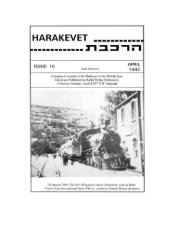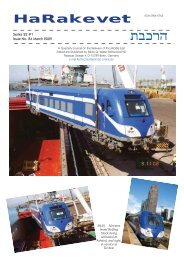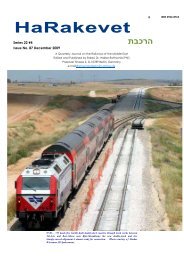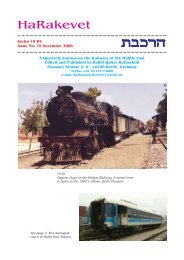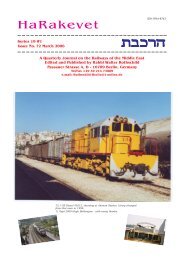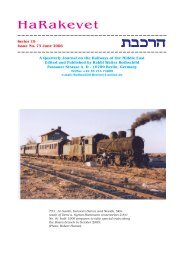You also want an ePaper? Increase the reach of your titles
YUMPU automatically turns print PDFs into web optimized ePapers that Google loves.
55509 55529 141 008 141 109<br />
55511 55531 141 010 141 111<br />
0 55534 141 013<br />
141 114<br />
1 55535 141 014<br />
141 115<br />
2 55536 141 015<br />
141 116 *<br />
3 55537 141 016<br />
141 117<br />
4 55538 141 017<br />
141 118 *<br />
5 55539 141 018<br />
141 119 *<br />
6 55540 141 019<br />
141 120<br />
7 55541 141 020<br />
141 101.<br />
Note: this is thirteen, not nine units! An<br />
asterisk indicates one not in the original list of units<br />
sold by Cotswold Rail. Units 141 116 has been<br />
described as being used for Fire Service training,<br />
118 was<br />
the 'Flower' weedkilling unit ......... but it is<br />
unclear how and when these were sold to Iran.<br />
Two photos accompanying the article<br />
show a pair of the units in red/cream WYPTE<br />
livery at Tehran depot in November<br />
2005 - by Alessandro Albe; and three in an<br />
attractive two-tone green plus white band and<br />
white roof livery, in summer 2007, by Toma Bacic.<br />
It seems from the latter that the entire lengthy UIC<br />
number is carried on the sides.<br />
(iv). NEW DIESEL LOCOS.<br />
From 'Eisenbahn Kurier' No. 450,<br />
3/2010, p.19.<br />
"Siemens builds the 'Iranrunner' ER 24.<br />
Siemens and the Iranian State Railways (RAI)<br />
signed a contract in December<br />
2006 for the construction of 150 Diesel locomotives,<br />
the contract being worth around<br />
G450M. These would be of Type ER 24 PC<br />
'Iranrunner'. The contract involves in the first phase<br />
the supply of 30 complete locos produced at the<br />
Siemens works in Munchen-Al-lach; in the second<br />
phase is a technology transfer for the construction<br />
of the remaining 120 locos in Iran, over a period of<br />
a further six years. Siemens' partner locally is<br />
Mapna Locomotive Engineering and Manufacturing<br />
Company (MLC), a subsidiary of the Iran<br />
Power Plant Projects Management (MAPNA).<br />
This loco type ER 24 PC, seen now for<br />
the first time in Germany, is a new member of the<br />
Siemens Mobility family, now a well-proven<br />
diesel-electric Eurorunner family with modular<br />
arrangement of the machine room and equipment.<br />
The 'Platform' concept of this diesel loco was so<br />
developed as to allow a maximum amount of<br />
variations to suit conditions and customer requirements<br />
with the minimum amount of extra problems<br />
- to include profile, gauge, power pack, tractive<br />
effort and top speed. These<br />
Bo-Bos have a driving cab at only one end, and this<br />
conforms to the standards established by<br />
TSI-Crash, as already fitted to the six-axle ER 20<br />
CF for Lithuania as well as the four-axle electric<br />
locos of CP Class 4700<br />
for Portugal and the SNCB Class 18 for Belgium.<br />
The type MTU 16V 4000 R46L diesel<br />
motors for the Iranian locos develop up to 2,400<br />
kW power and enable a top speed of 160 km/h. The<br />
87-ton loco has a starting effort of 270kN and as a<br />
special feature does not have central energy supply<br />
equipment (ZEV); the supply of energy to<br />
passenger trains will instead be arranged through<br />
Generator Coaches in the train."<br />
In 'Lok Magazin' 03/2010 p. 18 is a<br />
picture of one of the new locos in Munich, and the<br />
Arabic numbering is explained as '1502';<br />
presumably this was the second (or third) of the<br />
series.<br />
G. SAUDI ARABIA.<br />
(i) . MECCA - MEDINA.<br />
(Taken from the Port2Port web site,<br />
thanks to Evyatar Reiter):<br />
The British management company<br />
Scott Wilson has won the tender and will<br />
accompany the British railway project between<br />
Mecca and Medina. The company will provide<br />
consulting services, multifunctional to all aspects<br />
of railway infrastructure planning, design, project<br />
management, construction supervision etc. to the<br />
Saudi Railway Organisation (SRO) project to connect<br />
the two Moslem holy cities of Mecca and<br />
Medina. The contract is worth 89.8M Saudi Riyals<br />
($24M) and includes the preparation of tender<br />
documents, and analysis of financial and technical<br />
offers and compliance with international standards.<br />
Saudi Railways has also signed an<br />
agreement with a group, Al-Rajhi Consortium for<br />
the local civil engineering infrastructure works for<br />
the railway project between Mecca and Medina, a<br />
distance of some 450 miles, worth 6.7 Billion<br />
Riyals ($1.8 Bn.) The final tender for the project<br />
will be published in March 2010 and will include a<br />
construction and operation period of twelve years.<br />
(ii) . STAINLESS STEEL<br />
VARNISH.<br />
It is amazing what one stumbles across.<br />
The September 2009 issue of ,Rail-fan and<br />
Railroad' has an article (pp. 46f.) by Walt<br />
Lankenau on the restoration of an historic 1930's<br />
stainless-steel ,Zephyr' train at the Illinois Railway<br />
Museum in Union. This includes:-<br />
Budd delivered this set to״ the Chicago,<br />
Burlington & Quincy Railroad in late 1936 as one<br />
of two six-car ,Twin-City Zephyr' trainsets running<br />
between Minne-apolis-St. Paul and Chicago. They<br />
replaced a pair of three-car Pioneer Zephyr copies<br />
built in April1935 and numbered 9901 and 9902.<br />
The new ,Twin Zephyrs' were powered by separate<br />
shovel-nose diesel locomotives rather than by<br />
power cars articulated with the cars, as the earlier<br />
trains were. ElectroMotive built locomotives 9904<br />
,Pegasus' and 9905 ,Zephyrus' for the train, and<br />
soon a seventh car was added to each consist.<br />
EMC/Budd No. 9904.... powered the set that runs<br />
today at IRM. Its cars were named after the female<br />
Greek deities: 32-seat auxiliary power/cocktail<br />
lounge car ,Venus', 60-seat coaches ,Vesta' and<br />
,Minerva', 56-seat coach/16 seat dinette ,Psyche',<br />
diner ,Ce-res', 19-seat parlor/one drawing room<br />
,Di-ana', and 24-seat parlor observation ,Juno'),<br />
and so the consist was known as the ,Train of the<br />
Goddesses'. Its counterpart, the Train of the Gods,<br />
of course was made up of cars named ,Apollo',<br />
,Mars', ,Neptune', ,Cupid', ,Vulcan', ,Mercury' and<br />
,Jupiter'.<br />
The Trains of the Gods and Goddesses<br />
operated successfully on the ,Twin<br />
Zephyrs' until November 1947 .......... Afterward<br />
the two trainsets were replaced by new,<br />
Vista-Dome equipped Budd consists ......... and<br />
were reasssigned to the Chicago to Lincoln,<br />
Nebraska, ,Nebraska Zephyr'. For this<br />
service, two cars were removed from each<br />
consist - ,Diana', ,Psyche', ,Cupid' and ,Mercury'<br />
.<br />
The IRM acquired the Train of the<br />
Goddesses in September 12968, along with EMD<br />
E5 (built 1940/1). The Train of the Gods was sold<br />
to Saudi Arabia around the same time."<br />
Does anyone know more? One<br />
must assume all reference to pagan deities<br />
will have been removed before shipping,<br />
plus anything that looked like a cocktail<br />
bar<br />
H. TURKEY.<br />
(i). On 25th. January the following<br />
appeared on CercleFinance.com: According to my<br />
highly reliable translator, it means: It״ seems that<br />
Alstom is currently doing all it can to get an order<br />
from TCDD for 80 electric locomotives, according<br />
to Lettre״ de L'Expansion" (a weekly newspaper<br />
mostly about financial & economic news.) If the<br />
builder wins this bid worth more than 280 millions<br />
Euros, 8 locos will be assembled in France, the<br />
remaining will be assembled in Turkey by a<br />
subsidiary of TCDD, explains the Expansion"<br />
(ii) . POWER HAUL LOCOS.<br />
From 'Today's Railways UK' issue 96, Dec. 2009:<br />
p.61: An article on the first of the new Class 70<br />
PowerHaul locos for Freightliner in Great Britain<br />
reports that the first two locos were on their way<br />
from the General Electric Transportation plant at<br />
Erie, Pennsylvania, to Britain. "These are the first<br />
locos sold into the European market by GE<br />
Transportation. In December 2008 the company<br />
announced an agreement to supply Tulomsas (the<br />
privatised workshops of the Turkish State<br />
Railways) with the necessary technology and<br />
material to assemble PowerHaul locos in Turky for<br />
the European, Middle East and North African<br />
markets."<br />
Page 16<br />
הרכבת



